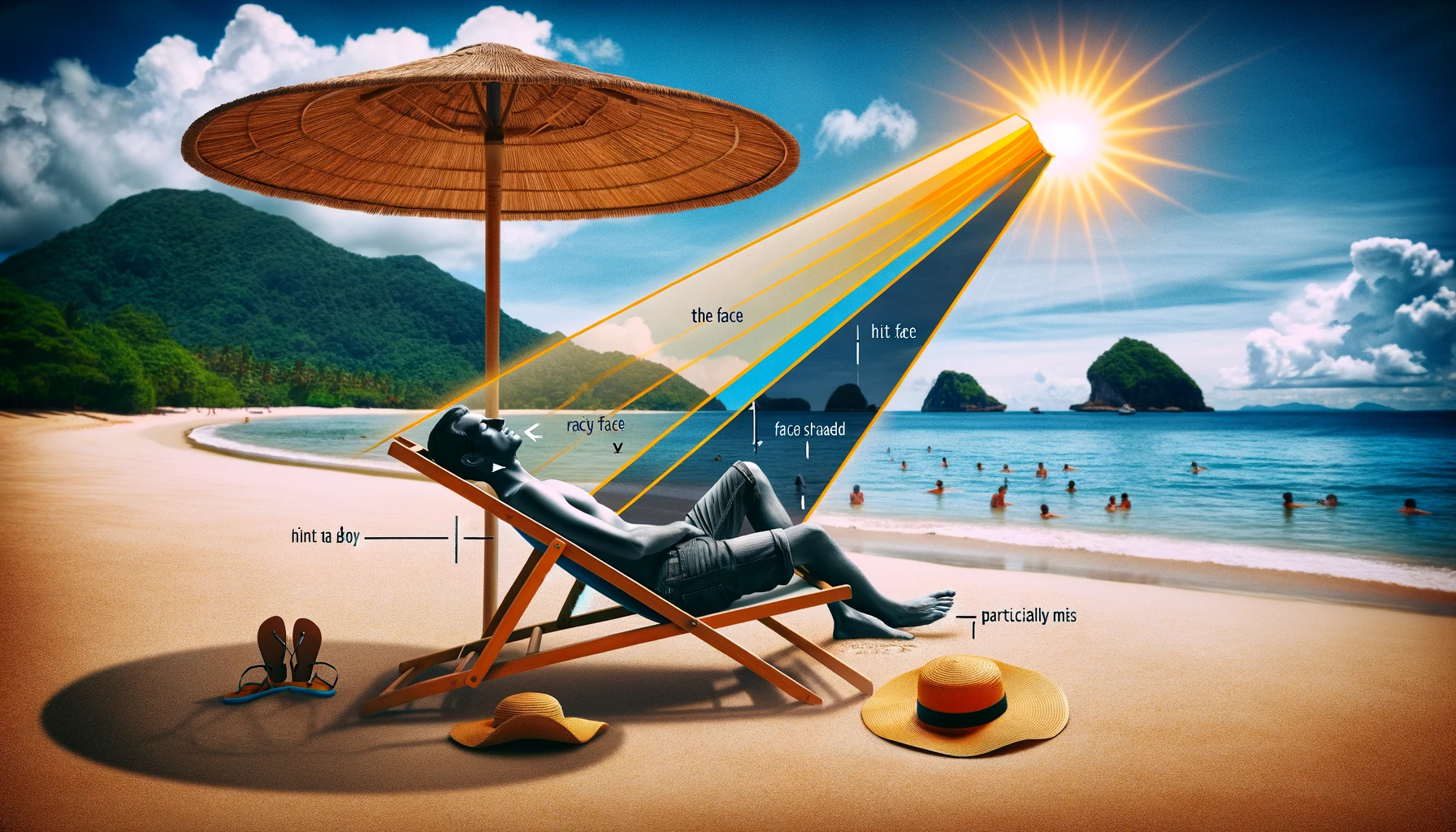Have you ever wondered why, after a sunny day lounging at the beach, your body radiates a golden glow while your face stubbornly refuses to catch up? This common conundrum has left many of us scratching our heads in puzzlement.
In this article, we’ll dive deep into the reasons behind this tanning tease and uncover some surprising truths. From my own trials to scientific insights, we’ll peel back the layers on why facial skin acts so differently under the sun.
Despite our best efforts for an even tan, our face’s defiance reveals a deeper story of sensitivity and protection. Join me as we explore everything about “Why Does My Face Not Tan?” and navigate the nuances of skincare and sun exposure
The Science of Tanning
Ever wondered “why does your Face Not Tan” and doesn’t catch up with the rest of your body’s golden hue after a day under the sun? Well, it’s time to understand the crucial science behind tanning. Your skin has a built-in defense mechanism against UV radiation.
When it senses the sun’s rays, it produces melanin, a pigment that absorbs UV and darkens the skin. This process is our body’s way to tackle the sun’s potentially harmful effects.
However, the face often requires additional protection, leading to a lighter complexion compared to the rest of the body. This unique reaction highlights the importance of respecting and protecting our skin’s natural responses to the environment.
The Unique Case of the Face
Your face, the protagonist of this story, behaves differently from the rest of your body when exposed to the sun. Here’s why:
Thinner Skin, Different Response
In this unique story, our protagonist isn’t the dashing hero or the mystical land; it’s our face. Unlike the rest of our body, our face behaves differently when exposed to the sun. Imagine stepping out, feeling the warmth envelop you, only to find your body basking in a golden hue while your face decides to walk a different path. This isn’t a tale of rebellion but a narrative woven by the delicate fabric of our facial skin.
In my journey to understand this peculiar character, I learned that our facial skin is akin to a thin, sensitive veil. It doesn’t tan as easily because, frankly, it’s built differently. Think of it as the cautious friend at a party, always aware, always protecting itself. While our body might dive into the sun’s embrace, our face is the one holding back, ensuring it doesn’t get too hurt in the process. It’s a fascinating dynamic, one that adds a layer of intrigue to our daily interactions with the sun.
High Maintenance
Ever noticed how despite basking under the same sun, your facial skin just won’t catch up with the tan on the rest of your body? It’s all down to the high maintenance it undergoes. Engaged in a rigorous daily routine of cleansing, exfoliating, and moisturizing, your face is in a perpetual state of constant renewal.
This relentless cycle is beneficial for your complexion, sure, but it comes at a cost. The top layer of skin cells is shed more frequently, making it significantly harder for a tan to develop or last.
Every time I prep my skin in the morning or wind down for the night, I’m essentially stripping away any hint of a tan, starting from scratch. It’s a frustrating revelation that has led me to appreciate the resilience and particular needs of facial skin.
This cycle of care, while essential for maintaining skin health, underscores why that sun-kissed glow remains elusive on my face, compelling me to look for alternative ways to achieve that desired bronzed look.
SPF: The Shield
In my quest to understand why my face doesn’t tan like the rest of my body, I stumbled upon an enlightening truth about SPF and its role as a formidable shield. Daily, we slather our face with facial products, including moisturizers and makeup, that boast SPF as a key ingredient. This sun protection is crucial for preventing damage from harmful UV rays, yet it also plays a significant role in inhibiting our face from tanning.
Through personal experience and a bit of research, I’ve realized that these facial products are double-edged swords. On one hand, they protect our most vulnerable skin from premature aging and skin cancer.
On the other, they are the very reason behind the tanning discrepancy between our face and body. It’s a trade-off I’ve come to accept, prioritizing skin health over a uniform tan.
External Factors Impacting Facial Tanning
It’s not just about biology; external factors play a significant role too:

Sunscreen Application
Ever noticed how your face doesn’t catch up with your body’s tan? The culprit often lies in our diligent sunscreen routine. Unlike other parts of our body, our faces receive a hefty dose of sunscreen, acting as a fortress against UV rays.
This protection is crucial, but it does limit the tanning process. From personal experience, I’ve found that reapplying sunscreen throughout the day, especially after a swim or a sweat, reinforces this shield.
While it might seem like a setback for achieving that even, sun-kissed glow, it’s a small price to pay for keeping our skin healthy and guarded against the sun’s harsh effects. So next time you ponder over your face’s lighter shade, remember the invaluable role your sunscreen plays.
Hats and Shades
In the quest for sun safety, hats and sunglasses have become staples in our outdoor accessories. They don’t just complete our summer looks but serve as a crucial shield for our face against the harshness of direct sunlight.
Reflecting on my own sunny escapades, it’s these very items that have often stood between me and an even tan. Naturally, with such protection, my face experiences less tanning compared to the rest of my body. It’s a trade-off, sure, but one that leans heavily on the side of health over aesthetics.

Angle of Exposure
Interestingly, the angle at which the sun’s rays hit your face versus your body plays a significant role in the tanning process. When sunbathing, your body is often directly exposed to the sun, soaking up those rays in full glory. However, your face tells a different story.
Due to its position, it’s frequently partially shaded or angled away from the sun, leading to less tan development. This phenomenon isn’t just about how we lay on the beach chair; it’s also about the built-in reflex to protect our faces from too much sun exposure, either by turning away or using hats and sunglasses as shields.
From personal experience, I’ve noticed that even when I’m diligent about applying sunscreen evenly across my body and face, the latter always tans at a slower pace, if at all. This observation led me to dig deeper into the science of sun exposure and its effects on our skin.
The realization that the angle of exposure significantly impacts the tanning process has made me more mindful about my time in the sun, encouraging a balance between seeking that sun-kissed glow and protecting my skin’s health.
The Health Perspective
When it comes to tanning, many of us notice a peculiar trend: our face refuses to catch up with the rest of our body’s bronze. Speaking from a blend of personal encounters and professional insights, this phenomenon isn’t just a quirk of nature.
Dermatologists emphasize a crucial distinction in protecting our face from the harsh embrace of UV radiation. Unlike the rest of our skin, our facial skin is on the frontline, bearing the brunt and shielding us from potential adversaries like premature aging, sunburn, and the dreaded skin cancer.
Embracing Protection
Sunscreen Is Your Best Friend
Ever slathered on sunscreen before a beach day, only to find your face remains as pale as it was in winter? That’s because broad-spectrum sunscreen is doing its job. Designed to protect against both UVA and UVB rays, it’s non-negotiable for maintaining healthy skin.
These rays are the culprits behind sunburn and skin damage, and while your body might catch some color, your face stays shielded under a fortress of SPF. This isn’t a sign of failure but a badge of honor for your skincare regime.
Protecting your face is crucial, as it’s more susceptible to premature aging and skin cancer risks. So, next time you’re wondering why your face isn’t tanning, remember, it’s because you’ve prioritized your skin’s health, and that’s something to be proud of.
Seek Shade
When it comes to protecting your skin from the sun, especially during those peak hours of direct exposure, finding shade is key. It’s a lesson I learned the hard way, after years of wondering why my face wouldn’t catch up with the tan on the rest of my body.
By strategically enjoying the outdoors while also seeking out spots under trees or umbrellas, I’ve managed to keep my skin healthier. It turns out, those peak hours between 10 a.m. and 4 p.m. are not just a danger zone for potential burns but also prime time for UV damage that can lead to more serious skin concerns.
So, remember, while soaking up the natural beauty outside, make sure to give your face a break from the sun’s intense gaze. It’s all about balancing the desire for a sun-kissed look with the need to keep our skin safe and sound.
Accessorize Wisely
When pondering over the puzzle of my face’s reluctance to tan, I discovered the game-changer in my sun protection arsenal: accessorizing. Hats and sunglasses aren’t merely fashion statements; they’re essential tools in shielding my face from the sun’s embrace.
My wide-brimmed hat acts as a personal patch of shade, effectively blocking the UV rays that attempt to kiss my skin. Meanwhile, my trusty sunglasses protect the delicate area around my eyes, preventing not just sunburn but also squinting, which can lead to wrinkles.
Embracing these accessories has transformed my outdoor experiences, ensuring my face remains protected while the rest of me gradually adopts a sun-kissed glow. It’s a strategic compromise, one that respects my skin’s health without forgoing the joy of sunny days.
Faking It: Safe Tanning Alternatives
If you’re after that sun-kissed glow without the sun’s kiss, consider these safer alternatives:
Self-Tanners
When diving into the world of self-tanners, the goal is always a natural-looking tan without the harsh UV damage that comes from traditional sunbathing. My journey led me to realize the importance of prepping my face to ensure an even application.

I learned quickly that to exfoliate was more than a simple step; it was the secret to unlocking a flawless glow. It rid my skin of dead cells, making way for the self-tanner to work its magic smoothly and uniformly.
The result? A tan that looked like I had spent a week in the sun, minus the worry of UV harm. It’s a revelation that changed my approach to achieving that coveted summer glow, proving that with the right products, you can look radiant and protect your skin simultaneously.
Bronzers
Ever wondered why your face struggles to catch up with the golden hue of your body? The answer could be simpler than you think. Let’s talk about Bronzers, a temporary fix for those seeking a tanned look without the sun’s embrace. My journey into the world of facial bronzers was born out of necessity.
Faced with a complexion that refused to tan, I discovered these gems that promised a sun-kissed glow without any UV damage. The beauty of bronzers lies in their ability to provide an instant tan that washes off at the end of the day.
It’s the perfect solution for a night out or a special event where you want your face to match the bronzed beauty of your body. No commitments, no harm, just the right touch of color that you can control.
Professional Spray Tans
Opting for a professional spray tan can ensure an even, natural-looking tan across your face without any sun exposure. From my own experience, finding the perfect balance between a sun-kissed glow and protecting my skin has always been a challenge.
My face, stubborn and resistant, never quite matched the bronzed hues of my body after a day in the sun. That’s when I discovered the magic of professional spray tans.
Not only did it give my face the color I desired, but it also allowed me to avoid the harmful effects of UV rays, making it a win-win situation.
Wrapping Up: A New Perspective
Understanding why your face does not tan like the rest of your body really sheds light on the importance of facial skin care and protection. The allure of a tan is understandable, but safeguarding your skin’s health is paramount.
By embracing SPF, seeking shade, and exploring safe tanning alternatives, you can enjoy the best of both worlds: a glowing complexion and well-protected skin. Remember, the sun will come and go, but your skin is with you for the long haul.
Frequently asked Questions
How can I make my face tan?
To make your face tan, consider using a facial tanner designed for sensitive skin, apply sunscreen with a lower SPF to get some sun exposure safely, and try to gradually increase your time in the sun to build a natural tan.
Why is my body tan but my face pale?
Your body may tan while your face remains pale due to more frequent application of high SPF sunscreen on your face, the use of facial products containing SPF, or more diligent protective measures like hats and sunglasses that shield your face from the sun.
What causes skin not to tan?
Skin may not tan due to high levels of melanin production that naturally protect against UV rays, consistent use of high SPF sunscreen which blocks UV radiation, or genetic factors that limit melanin production in response to sun exposure.
Why does my tan not stay on my face?
Tans may not stay on the face because the skin on your face is constantly renewing itself more quickly than on your body, stripping away tanned cells. Also, facial cleansing routines can accelerate the exfoliation of tanned skin.
Can wearing hats affect how my face tans?
Yes, hats shade your face from the sun, leading to less tan development compared to your body.
Does the angle of sun exposure affect facial tanning?
Yes, the angle can cause your face to be partially shaded or angled away, resulting in less tan.
Why do some people’s faces tan more easily than others?
Genetic differences, varying levels of melanin production, and skincare routines can affect how easily faces tan.
Is it possible to tan safely without damaging my skin?
Yes, by using sunscreen, limiting exposure during peak hours, and wearing protective clothing.
How do sunscreens prevent my face from tanning?
Sunscreens block UV rays, which are necessary for melanin production and tanning.
Are there any safe tanning alternatives for the face?
Yes, self-tanners, bronzers, and professional spray tans offer a tan look without harmful UV exposure.
How often should I reapply sunscreen on my face?
Every two hours or immediately after swimming or sweating to ensure continuous protection.
Can my skincare routine affect how my face tans?
Yes, frequent exfoliation and cleansing can remove tanned skin cells, preventing a lasting tan.
Why is facial skin more sensitive to the sun?
Thinner skin and constant exposure make facial skin more susceptible to sun damage.
How can I protect my face from the sun while tanning the rest of my body?
Use a lower SPF on your face for minimal protection while allowing some tanning, and gradually increase exposure time.
Does the type of sunscreen I use matter for facial tanning?
Yes, physical (mineral) sunscreens may offer better protection with less impact on tanning compared to chemical sunscreens.
Can dietary changes help improve my skin’s response to the sun?
Foods rich in antioxidants can protect skin from sun damage, potentially affecting how it tans.
Why do some areas of my face tan unevenly?
Uneven application of sunscreen, makeup, or natural skin variations can cause uneven tanning.
How does water exposure affect facial tanning?
Water can reflect UV rays, increasing sun exposure, but also strips away sunscreen, requiring more frequent application.
Can I use makeup with SPF instead of sunscreen?
Makeup with SPF can offer some protection, but it’s usually not enough for full sun exposure. It’s better to use a dedicated sunscreen.
What role do genetics play in how my face tans?
Genetics determine your skin’s natural melanin levels and response to UV radiation, affecting tanning ability.

 Medically reviewed by
Medically reviewed by